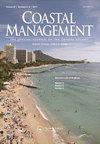The Origin of NOAA’s Integrated Ecosystem Assessment Program: A Retrospective and Prospective
IF 1.9
4区 环境科学与生态学
Q4 ENVIRONMENTAL SCIENCES
引用次数: 10
Abstract
Abstract In response to calls for marine ecosystem-based management (EBM), the U.S. National Oceanic and Atmospheric Administration (NOAA) developed a multidisciplinary science support framework called integrated ecosystem assessment (IEA). The IEA framework and a national NOAA program for implementing that framework were the culmination of many efforts in the 2000s. At a recent workshop, five leaders from the early days of NOAA IEA development participated in a panel to discuss the history of the framework and program, and to provide recommendations for future work. Panelists intended IEA to be a call to action for scientists and agencies to support EBM, and they designed the framework to be adaptable, scalable, and non-prescriptive so that it could be applied to a range of issues. Panelists emphasized the complementary nature of the processes, tools, and products that make up IEA efforts, and also stressed the need to adapt the IEA approach to shifting management and governance structures. Finally, panelists offered a range of recommendations for future development of the IEA approach, including: (1) broadening the stakeholder base; (2) developing objectives and reference points in partnership with end-users; (3) increasing diversity of IEA practitioners to better reflect the communities that IEA serves; (4) increasing development of readily updatable, real-time products; (5) carefully assessing and prioritizing the demands placed on IEA practitioners; (6) increasing collaboration across disciplines and resource sectors; (7) seeking opportunities to engage with emerging governance structures; and (8) strengthening support for IEA by effectively communicating its stories.美国国家海洋和大气管理局综合生态系统评估计划的起源:回顾与展望
摘要为了响应基于海洋生态系统的管理(EBM)的呼吁,美国国家海洋和大气管理局(NOAA)制定了一个多学科科学支持框架,称为综合生态系统评估(IEA)。国际能源署框架和国家海洋和大气管理局实施该框架的国家计划是2000年代许多努力的成果。在最近的一次研讨会上,NOAA IEA发展初期的五位领导人参加了一个小组讨论,讨论了该框架和计划的历史,并为未来的工作提供了建议。小组成员希望国际能源署呼吁科学家和机构采取行动支持循证医学,他们将该框架设计为适应性强、可扩展和非规范性的,以便将其应用于一系列问题。小组成员强调了构成国际能源署工作的过程、工具和产品的互补性,并强调有必要调整国际能源署的方法,以适应不断变化的管理和治理结构。最后,小组成员为国际能源署方法的未来发展提出了一系列建议,包括:(1)扩大利益攸关方基础;(2) 与最终用户合作制定目标和参考点;(3) 增加国际能源署从业人员的多样性,以更好地反映国际能源署所服务的社区;(4) 不断开发易于更新的实时产品;(5) 认真评估对国际能源机构从业人员提出的要求并确定其优先次序;(6) 加强跨学科和资源部门的合作;(7) 寻求参与新兴治理结构的机会;以及(8)通过有效宣传国际能源署的故事来加强对该署的支持。
本文章由计算机程序翻译,如有差异,请以英文原文为准。
求助全文
约1分钟内获得全文
求助全文
来源期刊

Coastal Management
环境科学-环境科学
CiteScore
6.00
自引率
0.00%
发文量
24
审稿时长
>36 weeks
期刊介绍:
Coastal Management is an international peer-reviewed, applied research journal dedicated to exploring the technical, applied ecological, legal, political, social, and policy issues relating to the use of coastal and ocean resources and environments on a global scale. The journal presents timely information on management tools and techniques as well as recent findings from research and analysis that bear directly on management and policy. Findings must be grounded in the current peer reviewed literature and relevant studies. Articles must contain a clear and relevant management component. Preference is given to studies of interest to an international readership, but case studies are accepted if conclusions are derived from acceptable evaluative methods, reference to comparable cases, and related to peer reviewed studies.
 求助内容:
求助内容: 应助结果提醒方式:
应助结果提醒方式:


